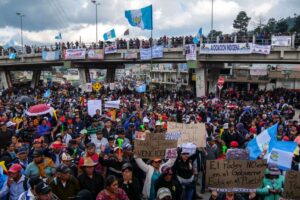This article is adapted from AQ’s special report on Guatemala and was updated on April 22 to include the IMF’s latest projections.
While Guatemala has higher economic growth rates and lower inflation than much of Latin America and the Caribbean, it lags the region in other key indicators. The nation’s macroeconomic stability belies levels of poverty, socio-economic inequality, food insecurity, and labor informality that are high even by regional standards.
In this overview, AQ gathers indicators on the country’s population, economy, and government that reflect relevant trends to monitor in the years ahead. Click here to access the full print version.
Society
In this nation of 18.7 million, 38.8% of Guatemalans self-identify as Indigenous. While Guatemalans and citizens from other Northern Triangle countries previously constituted a significant portion of encounters at the U.S. southern border, those figures have declined amid a crackdown on immigration in the U.S. and Mexico. Today, approximately 1.88 million Guatemalans reside in the U.S.
Poverty is a key driver of out-migration, and Guatemala’s rate of 54.8% in 2024 is more than twice the LAC average of 24.7% (these figures refer to the World Bank’s $6.85 in 2017 PPP poverty line). Undernourishment affects 12.6% of the population, and severe food insecurity affects 21.1% of Guatemalans. Public expenditure on education was 3.2% of GDP in 2022.
Economy
The country’s inflation is relatively low by regional standards, projected at 3% for 2025 versus 7.2% for LAC. The Guatemalan economy is known for its consistent growth levels, and the IMF forecast a 4.1% GDP expansion for this year, compared to the LAC average of 2%. Foreign direct investment (FDI) was $1.55 billion in 2023, lagging Costa Rica ($3.92 billion) and Panama ($2.02 billion). Guatemala’s FDI inflows surged in 2021 with Millicom’s acquisition of Tigo Guatemala for $2.2 billion.
The U.S. is Guatemala’s main trading partner, representing 32.1% of the country’s total trade, followed by Mexico at 8.9%. Commodities constitute an important share of exports: In February, the country’s top exports included coffee, clothing, sugar, and bananas.
Foreign remittances are a key driver of the Guatemalan economy, accounting for $21.5 billion, or 19% of GDP in 2024. The country’s labor productivity trails many regional peers, and labor informality reached 83.2% in 2023, the second-highest in the region after Bolivia at 84.5%, according to the ILO.
Government
Guatemala’s 2025 budget represents a 13.2% nominal increase compared to 2024. In line with the Bernardo Arévalo administration’s priorities, education received the largest allocation.
The nation has one of the region’s lowest debt-to-GDP ratios at 28%, outperforming Costa Rica at 61% and Panama at 56%. However, its tax-to-GDP ratio is low by regional standards. In 2022, Guatemala’s total tax revenues accounted for 14.4% of its GDP, compared to the 21.5% average for LAC and 34% for the OECD.
In Guatemala’s 160-seat unicameral legislature, the independent bloc comprises lawmakers from the governing Semilla party (23), UNE (5), and Nosotros (2). Semilla was suspended via a criminal court ruling in 2023 and later filed three injunctions, which are still pending.










